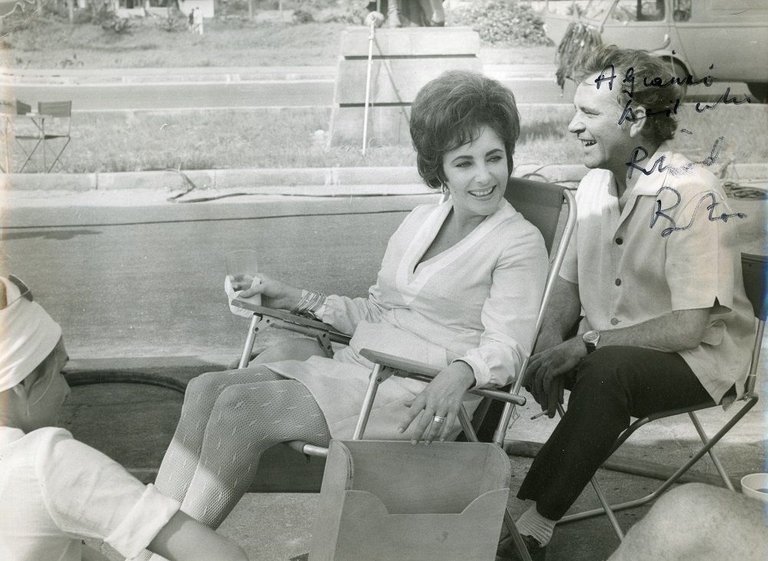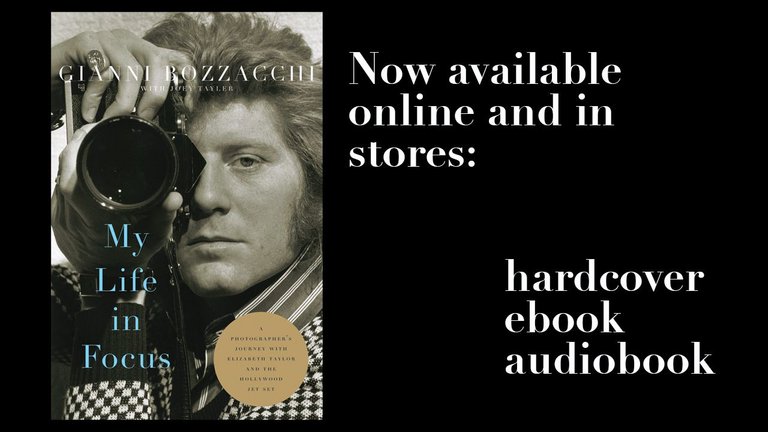The following is an excerpt from Gianni Bozzacchi's autobiography, "My Life in Focus: A Photographer's Journey with Elizabeth Taylor and the Hollywood Jet Set," which I co-wrote.
An Introduction to the Life and Work of Gianni Bozzachi
II. Welcome to the Jungle
The plane landed in the middle of nowhere. Cotonou airport consisted of a single landing strip, then jungle. Being fully immersed in Africa's nature was beautiful, exciting and terrifying all at the same time. The entire town boasted precisely two hotels: La Croix du Sud, a five-star place carved out of a half-star hotel, where most of the production lived, and the Hotel de la Plage, a smaller establishment run by French staff.
Franco and I stayed in the latter, though we also had a house rented by the production where, a couple of days later, we set up a darkroom when all the equipment arrived. We shot and developed a few trial photos to make sure everything worked properly. But the climate was so humid that the pictures took forever to dry, which meant we weren’t able to retouch them. So we decided to work at night, when it was a little cooler and the humidity less oppressive.
On my first day at work I met Bob Penn, the movie’s set photographer, and realized that Pierluigi had been lying to me from the start. Elizabeth Taylor’s press agent, Jean Osbourne, told me what I’d already guessed: under no circumstances could I photograph Elizabeth. It seems she’d liked a number of photos that Pierluigi’s agency had printed and retouched, and had asked them to send the person who’d done the retouching. Me. I later learned, in fact, that the only reason the production had hired Pierluigi’s agency at all was because Elizabeth had wanted the retoucher. Me.
I could take whatever photos I wanted of anyone else, but not Elizabeth who, at that stage in her career, had total control over who could and could not photograph her on set. I was to retouch Penn’s photos, and nothing else. That was Pierluigi’s way of putting me in my place, reminding me who was boss.
I was furious. But Franco and I had no choice, doomed to hang around on set, twiddling our thumbs, waiting until Penn handed us a roll to develop, print and retouch. So I buckled down, set to work as one of Pierluigi’s employees, and started taking a few photos of my own – of Richard and, yes, Elizabeth.

(The first picture I ever took of Elizabeth and Richard. Richard autographed it for me much later. Copyright Gianni Bozzacchi.)
With or without permission, I’d acquire the experience Pierluigi had promised me. Besides, I got the impression that Jean wasn’t all that worried about what some 22-year-old kid was up to, whatever his qualifications.
The only person I was able to communicate with reasonably on set was a splendid Corsican girl named Claudye, Elizabeth’s hairdresser. She’d trained under Alexandre de Paris, possibly the most famous hairdresser in history, the man who’d been there when Elizabeth got sick during the filming of “Cleopatra,” and is said to have flown to her bedside, creating her famous ‘artichoke cut’, while three nurses held her steady. Claudye thought she spoke Italian, when actually she spoke a Corsican dialect and I knew no more than a dozen words of French. We made all kinds of mistakes, but eventually understood each other. Pretty soon, whenever Claudye wasn’t busy with Elizabeth, she’d take me for a spin on her Solex. This flirtation with Elizabeth’s hairdresser made my presence even more irritating to the cast and crew.
I’ll never forget the avenue that led from the street to our hotel entrance, walled-in with thick ferns and other exotic plants. You felt as if you were forging through virgin jungle towards the distant light of civilization. The sensation turned dramatically acute one night around 3am when I got back in an unauthorized taxi, and had just started up the avenue when I suddenly heard rustling in the bushes. “Who’s there?” I demanded in Italian. No reply. “Hello?” Still no reply. But I knew for sure someone was lurking back there, so I grabbed my gun and cocked it loudly, determined to make sure that whoever was in those bushes knew all about it. Pointing the pistol straight ahead of me, I began moving backwards. “I’m armed,” I stuttered. “Come out slowly or I’ll start shooting!” In truth, I was terrified. Marlon Brando came stumbling out of the bushes, followed by Christian Marquand. They’d wandered off together into the shadows and both were drunk. Everyone in cinema already knew that Brando and Marquand were lovers by that time. But it was stunning news to me. I felt like I’d done something wrong, just being there and seeing what I’d seen. I thrust my pistol back into its holster and hurried towards the hotel entrance. Just think about it. If I’d been a tad jumpier that night, or if my finger had slipped ... No “Godfather,” no “Last Tango in Paris,” no “Apocalypse Now.”
A couple of days later Brando appeared on set, snuck up behind Elizabeth, brushed Elizabeth’s shoulder while she was getting made up, and grabbed her ass with both hands. Elizabeth turned, smiled and exclaimed, “Marlon!” Richard wasn’t nearly so amused. He ran over and pulled Marlon away. They argued and started punching each other. I immediately started snapping photos, imagining them published in some top magazine. I barely got a glimpse of my fantasy before Jean Osbourne grabbed my camera and tore out the roll.
When shooting ended in Africa, I returned to Rome, where I developed and printed my photos, made a few small touch-ups and handed them over to Pierluigi. Without telling me – or by mistake – he had all of them sent on to the production company, along with Bob Penn’s official photos. Elizabeth immediately noticed that a number of strange shots had been taken and wanted to know who’d done them. When she found out, she asked the producers to have me sent up to Nice, in southern France, where new sets had been built at the Victorine studios to continue interior shooting on “The Comedians.”
I was delighted, but kept asking myself, “Why me?” Was it because she liked the photos I’d taken without permission? Or because my images were better than those of the set photographer? Why me? It was a question I would ask myself often throughout my career. It’s a question rooted in insecurity, my lack of a proper education and what I used to feel was my lack of class.
Franco and I got to Nice and went straight to our hotel. But before we even had time to unpack, Elizabeth’s people came to get us and set us up in an apartment behind the famous Hotel Negresco. Elizabeth’s driver then picked me up and took me to her yacht, where she was waiting for me. The second I stepped onto the yacht I could tell she was annoyed with me.
“You’re good,” – she said – “But you’re an asshole for taking these without my consent.”
Despite this opening, she offered me a drink. Then, with Claudye helping translate, I explained the false promises that Pierluigi had used to persuade me to go to Africa, adding that I’d merely done the job I’d been sent to do. Elizabeth already knew about Pierluigi’s methods, and this helped ease the tension between us. Richard, on the other hand, was not very friendly. When I saw him, I stuttered: “Hi, Mr. BARton,” and he immediately corrected the way I’d mispronounced his name. I felt so embarrassed that I didn’t dare try to say his name again, and spent the rest of my time in Nice practicing my English vowels.
Come back on Monday for Part III, in which Gianni takes his first trip to the US in the Taylor-Burton entourage, meets a young Al Pacino, and catches the rough cut of a new Dustin Hoffman movie.
